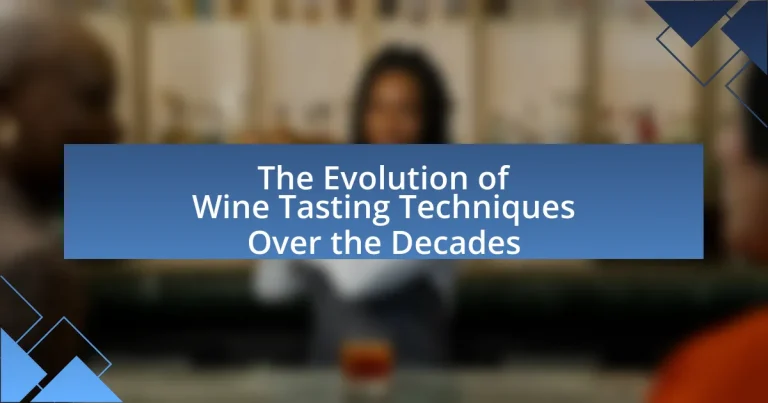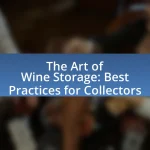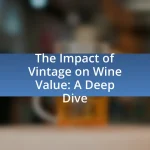The article examines the evolution of wine tasting techniques from ancient civilizations to the modern era. It traces the historical origins of wine tasting, highlighting practices from Mesopotamia, Greece, and Rome, where sensory evaluation methods were first developed. The discussion includes the influence of the Middle Ages and the Renaissance on wine tasting, the impact of formal wine competitions and education programs, and the role of technological advancements in contemporary tasting methods. Current trends, including the influence of social media and best practices for enhancing tasting skills, are also explored, providing a comprehensive overview of how wine tasting has transformed over the decades.
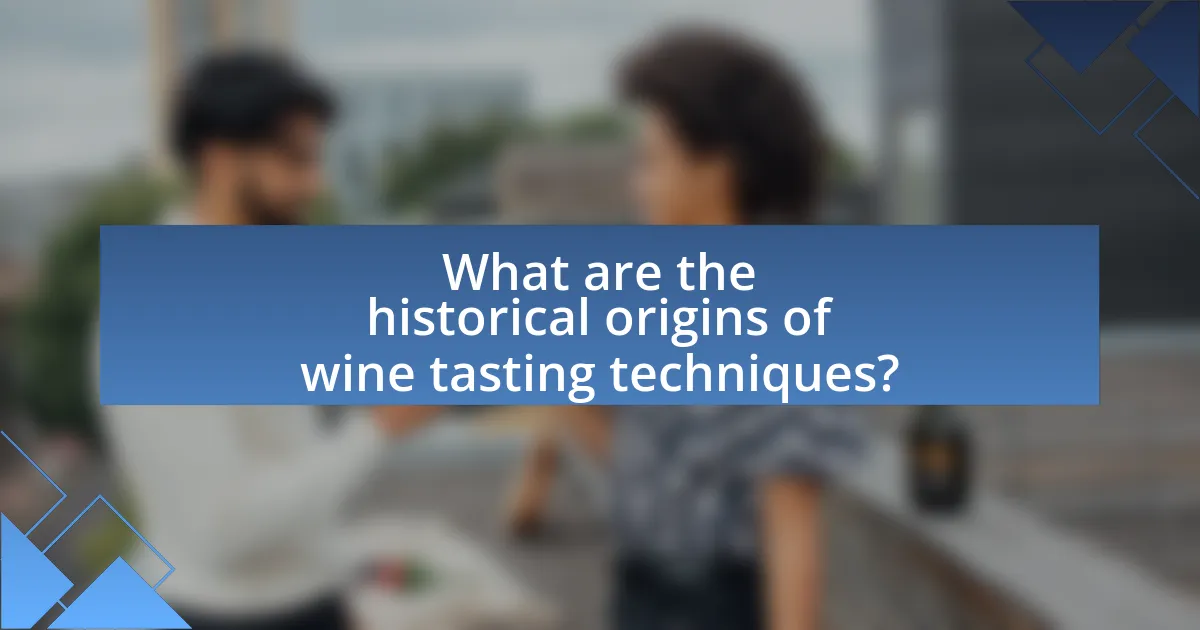
What are the historical origins of wine tasting techniques?
The historical origins of wine tasting techniques can be traced back to ancient civilizations, particularly in regions such as Mesopotamia and Egypt, where wine was first produced around 6000 BC. These early cultures developed rudimentary tasting methods to evaluate the quality of wine, often relying on sensory attributes like aroma and flavor. By the time of the Greeks and Romans, wine tasting had evolved into a more structured practice, with philosophers like Aristotle discussing the importance of sensory evaluation in wine appreciation. The Romans further refined these techniques, emphasizing the role of terroir and aging, which laid the groundwork for modern wine tasting practices. Historical texts, such as those by Pliny the Elder, provide evidence of these early methods, showcasing the significance of wine in social and cultural contexts.
How did ancient civilizations approach wine tasting?
Ancient civilizations approached wine tasting as a ritualistic and sensory experience, emphasizing the evaluation of flavor, aroma, and texture. For instance, the Greeks and Romans often held symposia, where participants would taste various wines, discussing their qualities and origins, which reflected their social status and cultural values. Historical texts, such as those by Pliny the Elder, detail the importance of wine in daily life and its role in religious ceremonies, indicating that tasting was not merely about enjoyment but also about discerning quality and appreciating craftsmanship. This structured approach laid the groundwork for modern wine tasting techniques, highlighting the significance of sensory evaluation in ancient practices.
What methods did the Greeks and Romans use in wine evaluation?
The Greeks and Romans used sensory evaluation methods, including taste, smell, and visual inspection, to assess wine quality. Greeks emphasized the importance of aroma and flavor, often using descriptors related to fruits, herbs, and spices to articulate their experiences. Romans built upon these practices, incorporating systematic tasting techniques that involved evaluating the wine’s color, clarity, and bouquet before tasting. Historical texts, such as those by Pliny the Elder, document these methods, highlighting the cultural significance of wine in their societies and the detailed attention given to its evaluation.
How did cultural practices influence early wine tasting techniques?
Cultural practices significantly influenced early wine tasting techniques by shaping the rituals and social contexts in which wine was consumed. In ancient civilizations such as Greece and Rome, wine tasting was often integrated into social gatherings and religious ceremonies, emphasizing communal experiences and the importance of wine in cultural identity. For instance, the Greeks held symposia, where wine tasting was accompanied by poetry and philosophy, fostering a deeper appreciation for the sensory qualities of wine. Additionally, the Romans developed formalized tasting methods, categorizing wines based on region and flavor profiles, which reflected their cultural emphasis on refinement and classification. These practices laid the groundwork for modern wine tasting techniques, highlighting the interplay between cultural values and sensory evaluation.
What role did the Middle Ages play in the evolution of wine tasting?
The Middle Ages significantly advanced the evolution of wine tasting by establishing structured practices and cultural appreciation for wine. During this period, wine became integral to social and religious rituals, leading to the development of specific tasting techniques to evaluate quality and flavor. Monastic communities, particularly in regions like Burgundy and Bordeaux, meticulously cultivated vineyards and documented their observations on wine characteristics, which laid the groundwork for systematic tasting methods. The emergence of wine guilds in the late Middle Ages further formalized the practice, promoting standards for quality assessment and enhancing the overall understanding of wine. This historical context illustrates how the Middle Ages contributed to the foundational principles of wine tasting that continue to influence modern practices.
How did monasteries contribute to wine tasting practices?
Monasteries significantly contributed to wine tasting practices by establishing systematic methods for evaluating and producing wine. Monks, particularly in regions like Burgundy and Bordeaux, meticulously documented their observations on grape varieties, fermentation processes, and aging techniques, which laid the groundwork for modern wine tasting. Historical records indicate that these religious communities not only cultivated vineyards but also developed criteria for assessing wine quality, focusing on aspects such as aroma, flavor, and clarity. This structured approach to wine evaluation helped refine tasting techniques that are still in use today.
What changes occurred in wine tasting during the Renaissance?
During the Renaissance, wine tasting evolved significantly as a result of increased emphasis on sensory evaluation and the development of more systematic tasting methods. This period saw the emergence of detailed descriptions of wine characteristics, including aroma, flavor, and texture, which were documented in texts by influential figures such as Leonardo da Vinci and Michel de Montaigne. Additionally, the Renaissance marked a shift towards a more scientific approach to viticulture and oenology, leading to improved wine quality and a greater appreciation for regional varietals. This transformation in wine tasting practices laid the groundwork for modern tasting techniques, emphasizing the importance of personal experience and critical analysis in the evaluation of wine.

How have wine tasting techniques evolved in the modern era?
Wine tasting techniques have evolved significantly in the modern era through the integration of scientific methods and technology. Contemporary wine tasters now utilize tools such as gas chromatography and mass spectrometry to analyze the chemical composition of wines, enhancing the understanding of flavor profiles and aromas. Additionally, the rise of sensory analysis training programs has improved tasters’ ability to identify and articulate specific characteristics of wines, leading to more standardized tasting notes. Research published in the Journal of Wine Research highlights that these advancements have resulted in a more systematic approach to wine evaluation, allowing for greater consistency and accuracy in tasting assessments.
What are the key developments in wine tasting from the 19th century to today?
Key developments in wine tasting from the 19th century to today include the formalization of tasting techniques, the establishment of wine ratings, and the rise of sensory analysis. In the 19th century, wine tasting became more structured with the introduction of systematic approaches to evaluating wine, such as the use of specific terminology to describe aromas and flavors. The establishment of wine competitions and the publication of wine guides in the late 19th century, such as the Bordeaux classification of 1855, further popularized wine ratings and helped consumers make informed choices. In recent decades, the incorporation of scientific methods, including sensory analysis and chemical profiling, has enhanced the understanding of wine characteristics, allowing for more precise evaluations. These developments reflect a shift from subjective opinions to a more standardized and analytical approach in wine tasting.
How did the introduction of formal wine competitions influence tasting methods?
The introduction of formal wine competitions significantly influenced tasting methods by establishing standardized criteria for evaluation. These competitions, such as the Judgement of Paris in 1976, introduced systematic approaches to assessing wine quality, emphasizing aspects like aroma, flavor, and finish. As a result, tasters began to adopt more structured methodologies, including the use of specific tasting notes and scoring systems, which enhanced objectivity and consistency in evaluations. This shift towards formalized tasting protocols has been documented in various wine literature, highlighting how competitions have shaped professional and amateur tasting practices alike.
What impact did the establishment of wine education programs have on tasting techniques?
The establishment of wine education programs significantly enhanced tasting techniques by providing structured methodologies for sensory evaluation. These programs introduced systematic approaches, such as the use of standardized tasting grids and vocabulary, which improved the consistency and accuracy of wine assessments. Research indicates that formal training increases the ability to identify and articulate flavor profiles, leading to more informed and nuanced tasting experiences. For instance, studies have shown that participants in wine courses demonstrate a higher proficiency in recognizing aromas and flavors compared to untrained individuals, thereby validating the positive impact of educational initiatives on tasting skills.
How have technological advancements changed wine tasting?
Technological advancements have significantly transformed wine tasting by enhancing the precision and accessibility of sensory analysis. Innovations such as digital aroma kits and advanced spectrometry allow tasters to identify and quantify specific compounds in wine, improving the accuracy of flavor profiles. For instance, gas chromatography-mass spectrometry (GC-MS) can detect volatile compounds that contribute to a wine’s aroma, providing objective data that complements traditional tasting methods. Additionally, mobile applications and online platforms have democratized wine tasting, enabling enthusiasts to share experiences and access expert reviews, thus broadening the community and knowledge base surrounding wine.
What role does technology play in wine evaluation today?
Technology plays a crucial role in wine evaluation today by enhancing precision and efficiency in the tasting process. Advanced tools such as gas chromatography and mass spectrometry allow for detailed chemical analysis of wine, identifying compounds that influence flavor and aroma. Additionally, software applications and databases facilitate the organization and comparison of tasting notes, enabling sommeliers and consumers to make informed decisions based on historical data and trends. The integration of artificial intelligence in wine evaluation further refines the process by predicting wine quality and pairing suggestions based on extensive datasets. These technological advancements have transformed traditional wine tasting into a more scientific and data-driven practice, improving overall quality assessment and consumer experience.
How have sensory analysis tools improved wine tasting accuracy?
Sensory analysis tools have significantly improved wine tasting accuracy by providing objective measurements of sensory attributes. These tools, such as gas chromatography and electronic noses, allow for precise identification of volatile compounds in wine, which directly correlate with flavor and aroma profiles. Research indicates that the use of these technologies can reduce subjective bias among tasters, leading to more consistent and reliable evaluations. For instance, studies have shown that trained panels utilizing sensory analysis tools can achieve a higher correlation in tasting notes compared to traditional methods, enhancing the overall reliability of wine assessments.
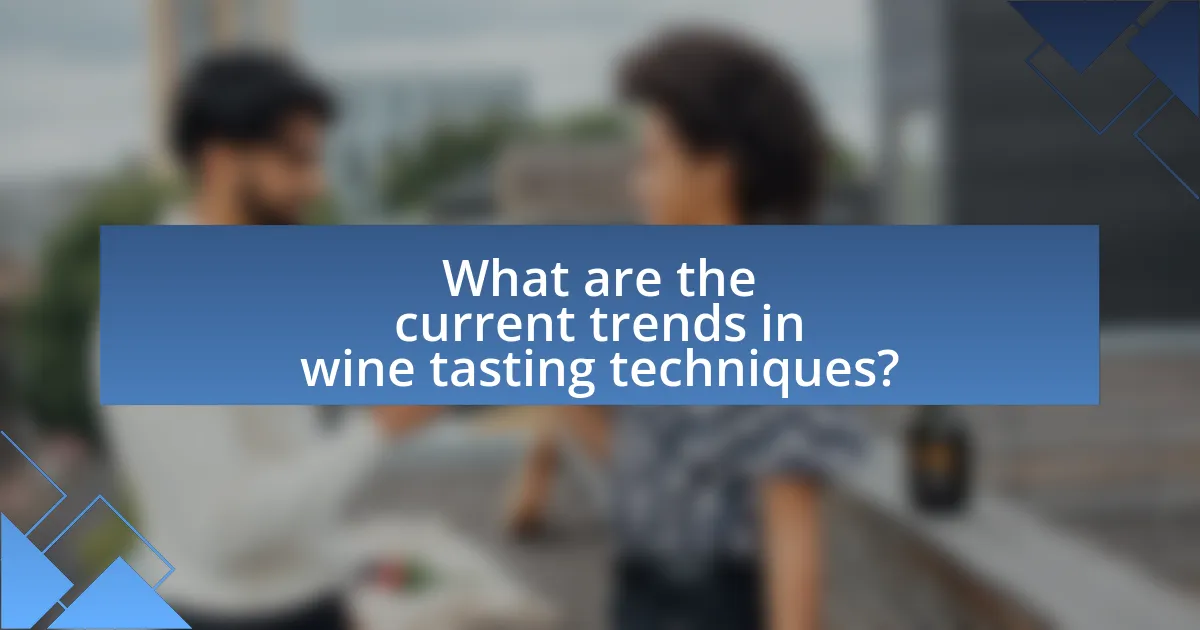
What are the current trends in wine tasting techniques?
Current trends in wine tasting techniques emphasize experiential and sensory engagement, focusing on the integration of technology and education. Wine tastings now often incorporate virtual reality experiences that allow participants to explore vineyards and wineries from around the world, enhancing the tasting experience through immersive storytelling. Additionally, there is a growing trend towards blind tastings, which help tasters focus on the sensory attributes of the wine without preconceived notions. Furthermore, educational workshops that teach participants about the science of tasting, including aroma identification and flavor profiling, are becoming increasingly popular. These trends reflect a shift towards a more interactive and informed approach to wine tasting, catering to both novice and experienced wine enthusiasts.
How has the rise of social media influenced wine tasting practices?
The rise of social media has significantly influenced wine tasting practices by enhancing accessibility and engagement among wine enthusiasts. Social media platforms allow users to share their tasting experiences, reviews, and recommendations in real-time, fostering a community of wine lovers who exchange knowledge and preferences. According to a study published in the Journal of Wine Research, 70% of wine consumers reported that social media influenced their purchasing decisions, highlighting the impact of online interactions on wine selection. Additionally, wineries utilize social media for marketing, creating virtual tastings and events that reach a broader audience, thus transforming traditional wine tasting into a more interactive and communal experience.
What are the implications of online wine tasting events?
Online wine tasting events have significant implications for the wine industry, including increased accessibility, expanded audience reach, and enhanced consumer engagement. These virtual events allow participants from diverse geographical locations to experience wine tasting without the constraints of travel, thereby broadening the market for wineries. According to a study by the Wine Market Council, 70% of consumers expressed interest in participating in virtual wine experiences, indicating a strong demand for this format. Additionally, online events facilitate direct interaction between winemakers and consumers, fostering a deeper connection and understanding of the products. This shift towards digital platforms also encourages wineries to innovate in their marketing strategies, adapting to changing consumer preferences and behaviors.
How do influencers shape modern wine tasting experiences?
Influencers shape modern wine tasting experiences by leveraging social media platforms to create engaging content that highlights unique wines and tasting events. Their ability to reach large audiences allows them to introduce new wine brands and trends, often leading to increased consumer interest and participation in wine tasting activities. For example, influencers frequently share visually appealing posts and videos that showcase wine pairings, vineyard tours, and tasting notes, which can significantly impact consumer preferences and purchasing decisions. This trend is supported by data indicating that 49% of consumers rely on influencer recommendations when making wine purchases, demonstrating their substantial influence in the market.
What are the best practices for contemporary wine tasting?
The best practices for contemporary wine tasting include evaluating the wine’s appearance, aroma, taste, and finish systematically. First, assess the wine’s color and clarity by holding the glass against a white background, which helps identify its age and varietal characteristics. Next, swirl the wine gently to release its aromas, then take a moment to inhale deeply, identifying various scents that can indicate the wine’s complexity and quality.
When tasting, take a small sip and let the wine coat your palate, paying attention to the balance of sweetness, acidity, tannins, and alcohol. This method allows for a comprehensive understanding of the wine’s flavor profile. Finally, consider the finish, or aftertaste, which can reveal the wine’s quality; a longer, more pleasant finish often indicates a superior wine.
These practices are supported by the Wine and Spirit Education Trust (WSET), which emphasizes the importance of a structured approach to tasting for both novice and experienced tasters.
How can individuals enhance their wine tasting skills?
Individuals can enhance their wine tasting skills by practicing systematic tasting techniques, which include evaluating the wine’s appearance, aroma, taste, and finish. Engaging in regular tastings with a focus on different varietals and regions allows individuals to develop their palate and recognize distinct flavor profiles. Research indicates that sensory training, such as using aroma kits, can significantly improve one’s ability to identify specific scents in wine, thereby enhancing overall tasting proficiency.
What common mistakes should be avoided during wine tasting?
Common mistakes to avoid during wine tasting include not properly assessing the wine’s appearance, neglecting to swirl the wine for aeration, and failing to take note of the wine’s aroma before tasting. Properly evaluating the wine’s color and clarity can reveal important information about its age and quality. Swirling the wine enhances its aroma, allowing for a more comprehensive tasting experience. Additionally, overlooking the aroma can lead to missing out on the wine’s full flavor profile, as a significant portion of taste is derived from smell. These practices are essential for a thorough and enjoyable wine tasting experience.
